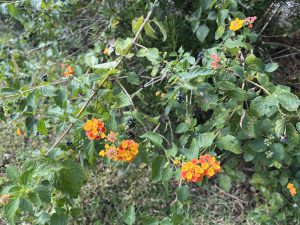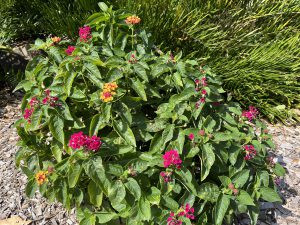
We’re ending our Happy Halloweeding series with one of the spookiest invasive weeds of all – lantana. Lantana strigocamara (also know as Lantana camara) is listed by the Global Invasive Species Database as one of the worst invasive species in the world and is documented in 60 countries.
Lantana is a deadly beauty. All parts of the plant are toxic and have poisoned children, pets and livestock. While it is still allowed to be sold in the United States, it is banned in other countries such as Australia. Lantana quickly forms dense thickets in a wide range of habitat types from forests to rivers and sand dunes. I came face to face with some of the largest lantana I’ve ever seen while working with the National Park Service at Fort Matanzas National Monument. In the back dunes along the coast where very sensitive native plants and wildlife live, we removed lantana that was well over 6 feet tall and had trunks 3 inches or more wide. How did it find its way to the middle of a private part of a national park, you may ask? Berries. Birds can carry the berries countless miles away where new populations of lantana soon start to invade. What’s more, lantana produces a natural chemical that inhibits other plants from growing near it, worsening its frightful ability to infest our natural areas and degrade habitat for our native wildlife.

Avoiding planting invasive lantana is the best way to managing this pest. Do also be warry of lantana sold as native and only purchase them from reputable nurseries. You can find nurseries that sell the native lantanas on the Florida Association of Native Nurseries website. The invasive lantana has been known to hybridize with the native species. There have been a few sterile cultivars or varieties of non-native lantana produced over the years that don’t produce berries and that aren’t able to hybridize with the native lantana. The University of Florida most recently released Bloomify(TM) Red, Bloomify(TM) Rose, and Luscious(R) Royale Red Zone (TM). These beautiful new sterile cultivars grow in lovely dense mounds without the fear of them spreading. We have some for display at the front of our UF/IFAS Marion County Extension Service demonstration gardens for you to see. However, although they are sterile, do remember they are still quite toxic to pets, livestock and children. If you’d rather avoid lantana entirely, you could consider instead native beach verbena (aka coastal mock vervain) that has attractive clusters of lavender flowers, beach sunflower, native blue porterweed, or the non-native, Florida-friendly, dwarf pentas that bloom in clusters of pink, red, pink
and purple that are also very attractive to hummingbirds and butterflies.

We hope you learned from and enjoyed this Happy Halloweeding series. If you have any questions or want Florida-Friendly Landscaping suggestions, please reach out to your UF/IFAS Marion County Extension Service at 352-671-8400 or your local UF/IFAS Extension Service in the county that you live.
Happy Halloweeding!
 1
1
